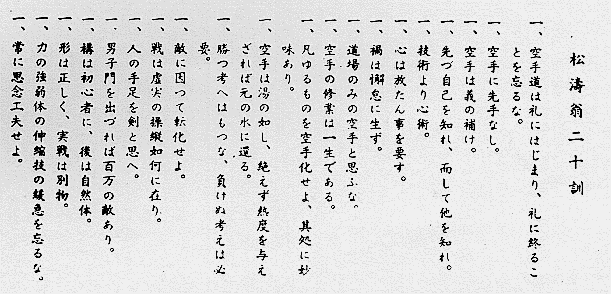Apply the way of karate to all things - therein lies its beauty
凡ゆるものを空手化せよ其処に妙味あり

This is the tenth in a series of posts to examine Shotokan’s niju kun, Gichin Funakoshi’s list of 20 guiding principles for karate.

The tenth principle is:
凡ゆるものを空手化せよ其処に妙味あり
In Romaji:
Arayuru mono o karate kaseyo; soko ni myōmi ari.
In English, I often see (and like):
Apply the way of karate to all things - therein lies its beauty.
But I think it sounds a bit more natural to say:
The beauty of karate is that it can be applied to everything.
Other translations I’ve seen include:
- When you learn how karate-do is related to everything, you will have discovered its essence.
- Put karate into your everyday living; that is how you will see its true beauty.
Since all of these translations are fairly similar it’s probably not worth examining the language, so let’s get right into what it means.
The gist of Genwa Nakasone’s interpretation is that, once you understand that that a single blow can mean life or death, you can apply this same seriousness of thought to any endeavor to achieve success. And when confronted with a situation that you don’t know how to handle, the physical and mental conditioning you’ve gained from karate will “reveal themselves.”
That my seem a bit extreme to modern readers, but Nakasone isn’t talking about everyday situations. He’s talking about dealing with situations with real consequences. But I think karate can be applied much more broadly in our everyday lives.
One thing karate teaches us is perspective. When you invite extremely skilled people to punch you in the face several times a week, it’s hard to be intimidated by some jerk at the office. Likewise, once you’ve been punched in the face a few times, you’re less likely to pick a fight, because you know what the consequences might be.
Another important lesson karate teaches is decisiveness. Indecision kills. If you stop to consider which block to use, you’ll be hit before you make that decision. I often tell my students to move immediately when I count, even if they do the wrong thing. I’d rather they do something than stand there thinking about what to do.
Karate also teaches compartmentalization. When I’m in the dojo, nothing outside the dojo matters. Likewise, it’s completely normal to kick someone in the head in class and then go out for a beer afterwards.
One of karate’s most important lessons is learning by helping others. I’ve learned more from teaching karate than I’ve ever learned from “doing” it on my own. On one hand, I’ve learned that you don’t really understand something unless you have at least two ways to explain it to a 6-year-old. On the other hand, my students are a reflection of my own karate. When I see several students making the same mistake, I ask myself if they’re really making a mistake or are they just doing it the way I taught them?
I could go on and on about how you can use karate in everyday life, but I think you get the idea. All of these “non-combative” skills karate teaches can be used in just about any situation. Furthermore, because karate has a way of “internalizing” itself, you will use those skills in everyday situations, whether you realize it or not.